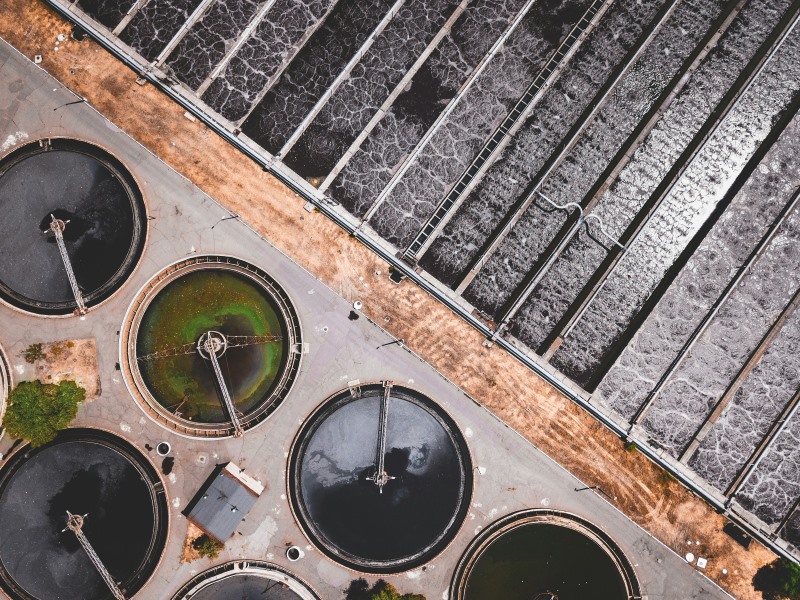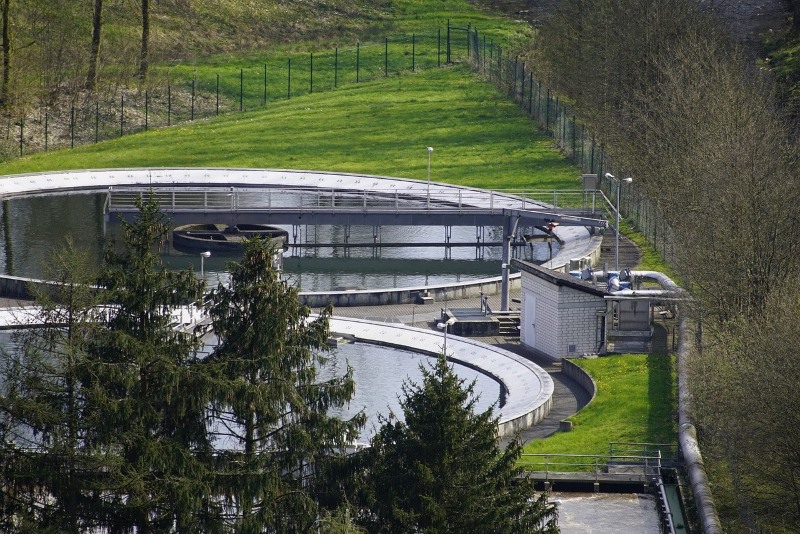
Wastewater, typically perceived as a challenge, possesses substantial potential as a renewable energy source. In this guide we explore the benefits and value of wastewater beyond its traditional perception as waste.
Wastewater, often misunderstood as mere waste, contains valuable organic matter, essential nutrients and energy-rich compounds. Despite its negative perception, millions of cubic metres are generated worldwide daily, presenting a vast reservoir of untapped resources for renewable energy production and resource recovery. Embracing a shift that recognises wastewater as a valuable resource, rather than a burdensome by-product, not only promotes environmental sustainability but also unlocks promising economic opportunities.
"Transitioning from a linear model of wastewater management to a circular economy approach holds the promise of a transformative shift in wastewater treatment."
Central to urban infrastructure, wastewater treatment plays an indispensable role in safeguarding public health and preserving environmental integrity. Yet, traditional approaches to wastewater treatment often adopt a narrow focus, prioritising the removal of pollutants and pathogens while overlooking the latent wealth of resources embedded within wastewater streams. By recalibrating this perspective from one of waste management to resource valorisation, there are substantial environmental and economic gains.
Transitioning from a linear model of wastewater management to a circular economy approach, wherein wastewater is viewed as a valuable input rather than a disposable output, holds the promise of a transformative shift in wastewater treatment practices.
Through the implementation of innovative technologies and strategic management strategies, water utilities can harness the inherent energy, nutrients and organic matter present in wastewater to drive sustainable solutions and foster a regenerative approach to resource utilisation.
Several processes are employed to harness energy from wastewater, each leveraging different mechanisms to convert organic matter into usable energy.
Anaerobic Digestion is a biological process that occurs in an oxygen-deprived environment, where a diverse consortium of microorganisms collaborates in breaking down organic matter present in wastewater.
These microorganisms, including bacteria and archaea, orchestrate a complex series of biochemical reactions, transforming complex organic compounds into simpler molecules. The cornerstone of this process lies in the microbial degradation of organic matter, yielding a plethora of by-products, most notably biogas.
Biogas, the primary product of anaerobic digestion, constitutes a gaseous mixture primarily composed of methane and carbon dioxide, along with trace amounts of other gases such as hydrogen sulphide and nitrogen. This versatile energy source holds immense potential for various applications, serving as a sustainable alternative to conventional fossil fuels. The methane content of biogas, in particular, renders it an excellent candidate for utilisation as a fuel for heating purposes, industrial processes, or electricity generation.
By harnessing the energy stored within organic matter, anaerobic digestion facilitates the reduction of the volume of solids in wastewater and offers a tangible pathway towards achieving energy self-sufficiency.
This transformative process not only mitigates environmental impacts associated with conventional wastewater treatment but also presents a viable means of generating renewable energy in the form of biogas.

MFCs are transforming the landscape of wastewater treatment and energy production. Harnessing the power of microbial communities, these innovative devices convert organic compounds found in wastewater into electricity with remarkable efficiency.
At the core of MFCs lies a symbiotic relationship between microorganisms and electrodes. As microorganisms break down organic matter in wastewater, they release electrons as a natural by-product of their metabolic processes. These electrons are then directed through an external circuit towards an electrode, generating an electrical current.
"Surplus energy is sufficient to meet the energy needs of the entire water cycle."
This electron flow, facilitated by specialised mediators or conductive materials, serves as the foundation for electricity generation in MFCs. The result? Clean and renewable energy that can be utilised for a myriad of applications, from powering small-scale electronics to supplementing grid electricity.
But the impact of MFCs goes beyond traditional wastewater treatment plants. These versatile devices offer promising solutions for decentralised wastewater treatment systems and off-grid energy production. In remote or resource-constrained areas lacking centralised infrastructure, MFCs provide a sustainable approach to both wastewater management and energy generation.
By tapping into the energy potential inherent in wastewater, MFCs empower communities to address sanitation needs while simultaneously producing clean electricity.
Thermal Hydrolysis is helping to unlock unlocking unprecedented energy recovery from organic matter in wastewater.
Organic compounds in wastewater are subjected to high temperatures and pressures, triggering hydrolysis reactions that break down complex molecules into simpler forms. Thermal decomposition primes the organic matter for efficient microbial degradation in subsequent treatment stages.
By jumpstarting the breakdown of organic matter, thermal hydrolysis turbocharges downstream processes like anaerobic digestion. The result? Increased bioavailability of sludge, leading to higher biogas production rates and maximum energy extraction from wastewater.
Thermal hydrolysis also has the potential to slash sludge volume and boosts overall process efficiency. By breaking down stubborn compounds, it eases operational challenges and enhances the sustainability of wastewater treatment systems.

Energy-positive water treatment plants operate by employing a combination of self-generating energy sources and renewables, such as solar power, wind turbines, or hydroelectricity to generate electricity.
They utilise advanced and energy-efficient technologies in their treatment processes, including high-efficiency pumps, motors, and filtration systems. Additionally, some plants use anaerobic digestion to break down organic matter like sewage sludge, producing biogas that can be captured and used as a renewable energy source.
"These initiatives have collectively reduced power consumption by approximately 1 GWh per year."
Combined Heat and Power (CHP) systems are often integrated to simultaneously produce electricity and heat from a single fuel source, maximising energy efficiency. These plants may also incorporate technologies to recover energy from wastewater itself, such as micro-hydro turbines that generate electricity from the flow of wastewater through pipes.
Sophisticated monitoring and control systems are employed to continuously monitor energy consumption and production, allowing operators to identify areas for improvement and maximise energy efficiency.
A €165 million upgrade will enable a wastewater treatment plant in southern France to generate twice as much energy as it consumes, as well as water for agriculture and industry.
Several nations and utilities have embraced the concept of energy generation from wastewater, implementing innovative technologies and strategies to maximise resource recovery.
Danish water utility Aarhus Vand operates an energy-positive wastewater treatment plant. Through advanced anaerobic digestion and combined heat and power (CHP) systems, the water utility not only achieves self-sufficiency but also generates surplus energy.
Over the past decade, at the Marselisborg wastewater treatment plant the utility has achieved a 25 per cent reduction in power consumption. Simultaneously, energy production has increased, resulting in the plant now producing 50 per cent more electricity than it consumes.
Surplus energy is sufficient to meet the energy needs of the entire water cycle, encompassing drinking water production, distribution, and the collection and treatment of wastewater.
Aarhus Vand has implemented various energy-saving technologies to achieve these outcomes. These include an advanced SCADA control system, a new turbo compressor, sludge liquor treatment based on the anammox process, and optimisation of the fine bubble aeration system.
These initiatives have collectively reduced power consumption by approximately 1 GWh per year. Furthermore, the utility has significantly improved energy production through the implementation of energy-efficient biogas engines through CHP. Additionally, it has installed a heat exchanger with the aim of supplying surplus heat to the district heating grid, representing around 2 GWh per year.
Aarhus Vand's approach highlights the effectiveness and cost-efficiency of wastewater treatment at larger facilities. By consolidating operations into fewer, but larger plants, the organisation not only reduces operational and maintenance costs but also streamlines management processes.
Additionally, the adoption of energy-saving technologies proves to be a sound investment, resulting in both financial savings and a reduced environmental footprint.

Meanwhile German utility Hamburg Wasser has also made significant strides in energy generation from wastewater. By employing advanced anaerobic digestion technologies and implementing efficient sludge treatment processes, the utility minimises energy consumption while maximising energy recovery. The integration of renewable energy sources, such as biogas and solar power, further enhances the sustainability of wastewater treatment operations.
The innovative approaches adopted by Hamburg Wasser work through the separation of three distinct wastewater streams: black water from toilets, grey water from showers and washing, and rainwater. These streams are collected and treated separately, with a focus on black water treatment as the primary element.
"Surplus energy is sufficient to meet the energy needs of the entire water cycle."
Utilising a 3.7-kilometer vacuum network, black water from toilets is transported to a depot located in the industrial park of Jenfelder Au. Here, it undergoes fermentation alongside co-substrate in a fermenter, resulting in the production of biogas. Biogas is then converted into electricity and heat through a combined heat and power plant.
This process yields approximately 450,000 kilowatt hours of electricity and 690,000 kilowatt hours of heat annually, equivalent to the energy needs of 225 households for electricity and 70 households for heat, based on average consumption in Hamburg.
“This approach not only reduces CO2 emissions but also achieves self-sufficiency in energy provision for the neighbourhood it operates in,” said Nathalie Leroy, MD of Hamburg Wasser.
PUB, Singapore's national water agency, has implemented innovative technologies to maximise resource recovery from wastewater. The Tuas Nexus project, scheduled for completion in 2025, integrates wastewater treatment with energy and food production.
By co-locating wastewater treatment plants with water reclamation facilities and renewable energy generation systems, PUB aims to achieve greater energy self-sufficiency and resource optimisation.
"By harnessing the renewable energy potential within wastewater streams, water utilities can play a crucial role in advancing the transition."
Meanwhile, the United States Environmental Protection Agency (EPA) has also supported research and development initiatives aimed at advancing energy generation from wastewater.
Through programmes such as the Water Infrastructure Finance and Innovation Act (WIFIA) and the Clean Water State Revolving Fund (CWSRF), the EPA provides funding and technical assistance to water utilities seeking to implement energy recovery technologies. These initiatives promote innovation and sustainability in the water sector, fostering the adoption of renewable energy solutions.
A paradigm shift is underway, with wastewater being viewed not as a mere waste product but as a valuable resource for renewable energy generation. This shift marks a pivotal moment in environmental stewardship, showcasing the untapped potential within wastewater treatment plants for sustainable energy production.
By implementing innovative technologies such as anaerobic digestion, microbial fuel cells and thermal hydrolysis, water utilities worldwide are transforming their facilities into energy-positive hubs. These advancements not only fulfil their own energy needs but also contribute surplus energy to the grid, paving the way for a more resilient and low-carbon future.
Inspired by success stories from utilities like Aarhus Vand in Denmark and Hamburg Wasser in Germany, the feasibility and tangible benefits of energy generation from wastewater are becoming increasingly evident. These initiatives highlight the transformative impact of embracing circular economy principles in wastewater management, turning liabilities into assets for sustainable development.
Amidst the pressing need to combat climate change, wastewater is a promising solution, offering environmental and economic benefits on a global scale. By harnessing the renewable energy potential within wastewater streams, water utilities can play a crucial role in advancing the transition towards a more sustainable energy future.